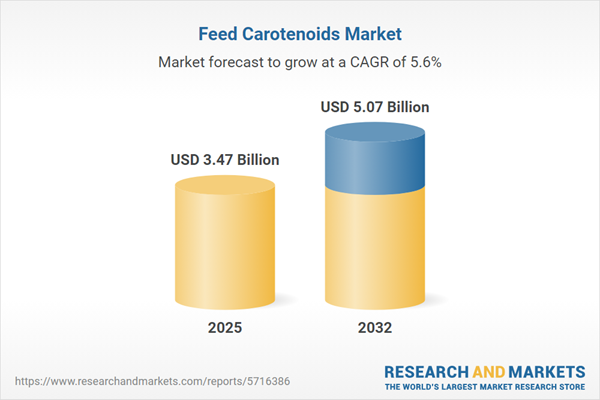Speak directly to the analyst to clarify any post sales queries you may have.
The feed carotenoids market is redefining its strategic landscape as industry leaders contend with evolving regulations, shifts in supply chain design, and increasing sustainability imperatives. Senior decision-makers must balance growth targets, compliance challenges, and innovation while fostering competitive advantage in a rapidly changing environment.
Market Snapshot: Feed Carotenoids Market Size and Trends
The feed carotenoids market achieved a value of USD 3.28 billion in 2024 and is expected to reach USD 3.47 billion in 2025, with projections targeting USD 5.07 billion by 2032. Spurred by a 5.60% compound annual growth rate, this market’s momentum is attributed to heightened use of carotenoids for animal nutrition and product differentiation, particularly in aquaculture, poultry, and livestock sectors. Companies pursue expanded product development and innovation, responding to rising demand for feed additives that deliver health and coloration benefits. At the same time, regulatory adjustments and environmental concerns are steering investments toward efficient supply chains and regionalized responses.
Scope & Strategic Segmentation
- Animal Types: Feed carotenoids are applied across aquaculture, poultry, ruminant, and swine nutrition, supporting goals in protein yield, product pigmentation, and animal wellness.
- Form Types: Variants include granular, liquid, powder, and microencapsulated formats, offering manufacturers the flexibility necessary for optimal storage, compatibility, and nutrient delivery strategies.
- Source Options: Businesses select among natural carotenoids—derived from algae, plants, or microbes—or synthetic alternatives, each with unique implications for sustainability objectives and production efficiency.
- Applications: Central benefits of carotenoids in feed include antioxidant properties, targeted coloration effects, and enhancements to animal health, addressing both operational and market-driven needs.
- Carotenoid Types: Key compounds incorporated are astaxanthin, canthaxanthin, beta carotene, and lutein, each tailored for specific impacts on animal performance and the differentiation of end-products.
- End Users: The market serves commercial feed mills, integrated operations, and independent producers, with each segment influencing demand patterns and procurement practices in the supply chain.
- Distribution Channels: Direct sales, distributor relationships, and digital platforms are employed to broaden reach and facilitate responsive service across established and emerging customer bases.
- Manufacturing Processes: Carotenoids are produced through fermentation, chemical synthesis, biotechnological methods, and extraction, with these processes evolving to match changing regulatory and market preferences.
- Geographical Regions: Strategic attention is given to the Americas, Europe, Middle East & Africa, and Asia-Pacific, as region-specific regulations, supply issues, and demand cycles shape market activity and investment priorities.
- Key Companies: Leading industry players include Koninklijke DSM N.V., BASF SE, Kemin Industries, Adisseo S.A.S., Chr. Hansen Holding A/S, Weishardt S.A.S., Lonza Group Ltd., Novus International, Zhejiang NHU Co., and Fermenta Biotech Limited, all of whom drive product innovation and strategic expansion.
Key Takeaways for Senior Decision-Makers
- Adoption of microencapsulation and nanoemulsion technologies is advancing product stability and bioavailability, supporting more consistent animal nutrition outcomes and operational efficiency.
- Expanding ingredient sourcing and supplier relationships—especially focusing on algae- and microbe-based sources—improves resilience and helps sustain production through fluctuating supply landscapes.
- Agility in formulation and procurement practices enables organizations to adjust quickly to regulatory changes, supporting schedule adherence and product compliance across geographies.
- Utilization of local feed ingredients or byproducts supports sustainability goals and can decrease reliance on imported materials, thus reducing vulnerability to external market shifts.
- Strategic alliances, including acquisitions and partnerships across sectors, are pivotal for scaling presence and market access, particularly in regions experiencing rapid growth or regulatory evolution.
- Improved quality assurance and traceability systems not only reinforce partner confidence but also streamline manufacturing processes for regulatory and commercial competitiveness.
Tariff Impact: Navigating 2025 Trade Shifts
Imminent tariff adjustments in the United States are poised to elevate input costs for feed carotenoid producers. In anticipation, organizations are diversifying supplier networks, renegotiating procurement contracts, and investing in domestic production capacity. Ongoing monitoring of supplier responsiveness will be necessary to maintain regulatory compliance and mitigate potential disruptions as trade landscapes evolve.
Methodology & Data Sources
This analysis employs desk research, executive-level interviews, and quantitative surveys. Each finding is validated through peer reviews and data triangulation to ensure business leaders access timely and actionable insights for the animal nutrition industry.
Why This Report Matters for Feed Carotenoids Market Leadership
- Comprehensive segmentation and transparent competitor insights offer procurement and supply leaders clearer pathways to manage risk and enhance agility.
- Research-driven recommendations empower executives to anticipate operational roadblocks, shape adaptable policies, and secure business continuity.
- Tactical guidance spurs technology integration and sustainability initiatives to build lasting market strength and customer value.
Conclusion
Strategic focus on technological innovation, resilient sourcing, and sustainability is crucial for organizations aiming to maintain market leadership and capitalize on emerging opportunities in the feed carotenoids sector.
Additional Product Information:
- Purchase of this report includes 1 year online access with quarterly updates.
- This report can be updated on request. Please contact our Customer Experience team using the Ask a Question widget on our website.
Table of Contents
3. Executive Summary
4. Market Overview
7. Cumulative Impact of Artificial Intelligence 2025
Companies Mentioned
The companies profiled in this Feed Carotenoids market report include:- Koninklijke DSM N.V.
- BASF SE
- Kemin Industries, Inc.
- Adisseo S.A.S.
- Chr. Hansen Holding A/S
- Weishardt S.A.S.
- Lonza Group Ltd.
- Novus International, Inc.
- Zhejiang NHU Co., Ltd.
- Fermenta Biotech Limited
Table Information
| Report Attribute | Details |
|---|---|
| No. of Pages | 180 |
| Published | October 2025 |
| Forecast Period | 2025 - 2032 |
| Estimated Market Value ( USD | $ 3.47 Billion |
| Forecasted Market Value ( USD | $ 5.07 Billion |
| Compound Annual Growth Rate | 5.6% |
| Regions Covered | Global |
| No. of Companies Mentioned | 11 |









